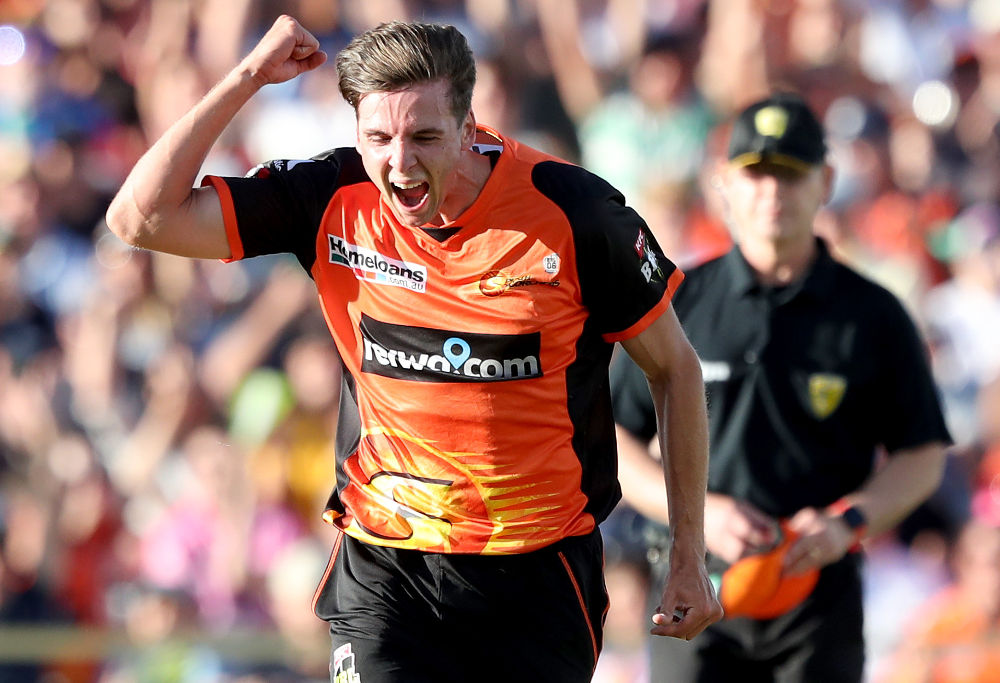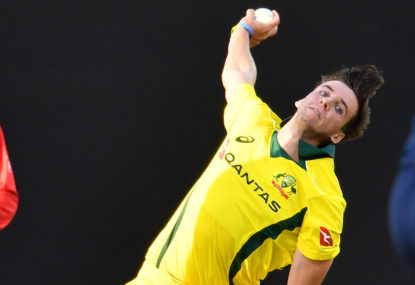Jhye Richardson’s shock promotion to Australia’s Test squad has angered many fans, but it shouldn’t distract from the fact the 21-year-old is a rare talent with the ability to shine in all three formats at international level.
Richardson was picked in Australia’s 15-man squad for next month’s four-Test tour of South Africa, with prolific swing bowler Chadd Sayers snubbed, despite dominating the Sheffield Shield for the past five years.
Sayers was in Australia’s Ashes squad this summer, yet told media this week he didn’t get a phone call from the selectors explaining why he’d been overlooked for the South Africa tour.
Chairman of selectors Trevor Hohns explained to the press why they’d instead picked Richardson, citing his startling pace as a major factor. While Sayers is extremely unlucky to never have played for Australia, I understand the selectors’ method.
They have long sought to have variety in the pace attack. They see express left-armer Mitchell Starc, accurate seamer Josh Hazlewood, and standover man Pat Cummins as playing three distinct roles. It was the same story when they previously had the brute force of Mitchell Johnson, the high-speed swing of Ryan Harris, and the relentless precision of Peter Siddle.
This variety has served Australia well – their Test attack has been consistently effective across all countries and conditions for the past four years. The only genuinely poor series an Aussie attack has had in that time was in the UAE against Pakistan, just over three years ago, on two of the deadest pitches imaginable.
Variety has been key to that success.
[latest_videos_strip category=”cricket” name=”Cricket”]
We saw the flipside of that in the Ashes, as England’s brigade of right-arm, 135kmh bowlers formed a smorgasbord for the Australian batsmen. Not to mention at the MCG, where a Starc-less Australia suddenly looked far more one dimensional with an attack of Jackson Bird, Hazlewood and Cummins.
In South Africa next month, the selectors clearly see Bird as the back-up for Hazlewood. That’s Bird’s best position. Both men are very similar in style – 195cm right-armers who seek to land delivery after delivery just outside off stump on an in-between length.
They don’t seek to bowl miracle deliveries, rather they play on the batsmen’s patience with their accuracy and persistence. Sayers, too, is in this mould. That’s why he was considered surplus to requirements.
Of course, there’s a strong case to be made that Australia could do with at least two, or even three such precise operators when faced with a green seamer, which is quite possible at some point in the series in South Africa. But after Starc, Cummins and Hazlewood’s dominant display in the Ashes, there was never a chance two of them would be dropped to make way for both Bird and Sayers on a green deck.
With Bird firmly entrenched as Hazlewood’s understudy, Sayers very likely would have been reduced to a net bowler. It made more sense for the second reserve paceman to be a back-up for Cummins and Starc.
If not for their injuries, James Pattinson or Nathan Coulter-Nile would have been the leading contenders to fill this spot. With that pacy pair unavailable, there were limited options for quicks who can consistently bowl above 140kmh – Chris Tremain would have been my choice.
Not only is Tremain sharp – he was clocked at 148kmh in his debut ODI series in South Africa in 2016 – but he’s also been consistently excellent in the Shield, with 100 wickets at 20 over the past three seasons.
Given the make-up of Australia’s Test squad, Tremain was more unlucky than Sayers to miss out.
Instead, it was Richardson who was picked as the express understudy. The West Australian boosted his stocks with an impressive ODI debut against England last week, outbowling both Starc and Cummins in that match, operating with a precision the pair could not match.
Despite his inexperience – Richardson had played just eight List A matches prior to that match – the right-armer looked comfortable from his first over.
This continues a trend for Richardson, who has quickly found his feet in every format since making his State debut just weeks after his 19th birthday.
He appears to have generous faith in his own ability, and who could blame him given the remarkable gifts he possesses. Richardson has been clocked at up to 150kmh and is capable of bowling consistently in the 142-146kmh range, similar to Cummins.

Jhye Richardson (AAP Image/Richard Wainwright)
Most bowlers who operate at such pace, particularly younger ones, does so at the expense of their accuracy. Not Jhye. He is impressively precise for a young express quick. Granted, he is not in the same league as Hazlewood, Bird or Sayers when it comes to suffocating batsmen, yet he’s still comfortably more accurate than Starc.
Of course, the sample size is small when assessing Richardson’s first-class career – he’s played only five games. As much as his haul of 21 wickets at 25 in those matches, what stands out is his fantastic strike rate of 46. Richardson is a natural wicket-taker.
He has a lovely out swinger, a lethal yorker, and a skiddy bouncer which frequently surprises batsman. In terms of style, he is similar to a young Dale Steyn, who also happens to be the bowler Richardson says he modelled himself on.
That’s not to suggest he can go close to matching the feats of Steyn, the greatest pace bowler of the past decade. However, with his pace, aggression, confidence and skill, there is a great deal about Richardson which appeals.
He might not be ready for Test cricket just yet, but Richardson has all the attributes to become a regular for Australia in all three formats.






























































































